instrument panel PONTIAC PONTIAC 1997 Owners Manual
[x] Cancel search | Manufacturer: PONTIAC, Model Year: 1997, Model line: PONTIAC, Model: PONTIAC PONTIAC 1997Pages: 419, PDF Size: 19.67 MB
Page 19 of 419

The person keeps going until stopped by something.
in a real vehicle, it could be the windshield
...
or the instrument panel ...
1-11
ProCarManuals.com
Page 31 of 419

I A CAUTION:
Air bags inflate with great force, faster than the
blink of an eye. If you’re too close to an inflating
air bag,
it could seriously injure you. Safety belts
help keep you in position before and during a
crash. Always wear your safety belt, even with
air
bags. The driver should sit as far back as possible
while still maintaining control
of the vehicle.
SRS AIR BAG
There is an air bag readiness
light on the instrument
panel, which shows SRS
AIR BAG.
An inflating air bag can seriously injure small
children. Always secure children properly in your
vehicle.
To read how, see the part of this manual
called Whildren” and the caution label on the
right front passenger’s safety belt.
The system checks the air bag electrical system for
malfunctions. The light tells
you if there is an electrical
problem. See “Air Bag Readiness Light” in
the Index
I for more information.
1-23
ProCarManuals.com
Page 32 of 419
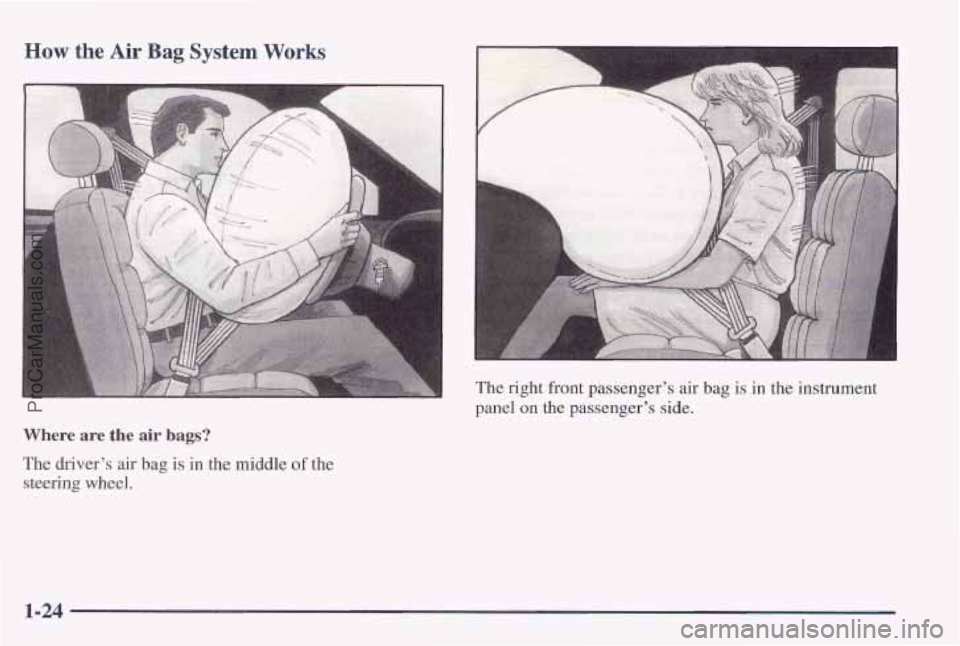
How the Air Bag System Works
Where are the air bags?
The driver's air bag is in the middle of the
steering
wheel.
The right front passenger's air bag is in the instrument
panel
on the passenger's side.
1-24
ProCarManuals.com
Page 33 of 419
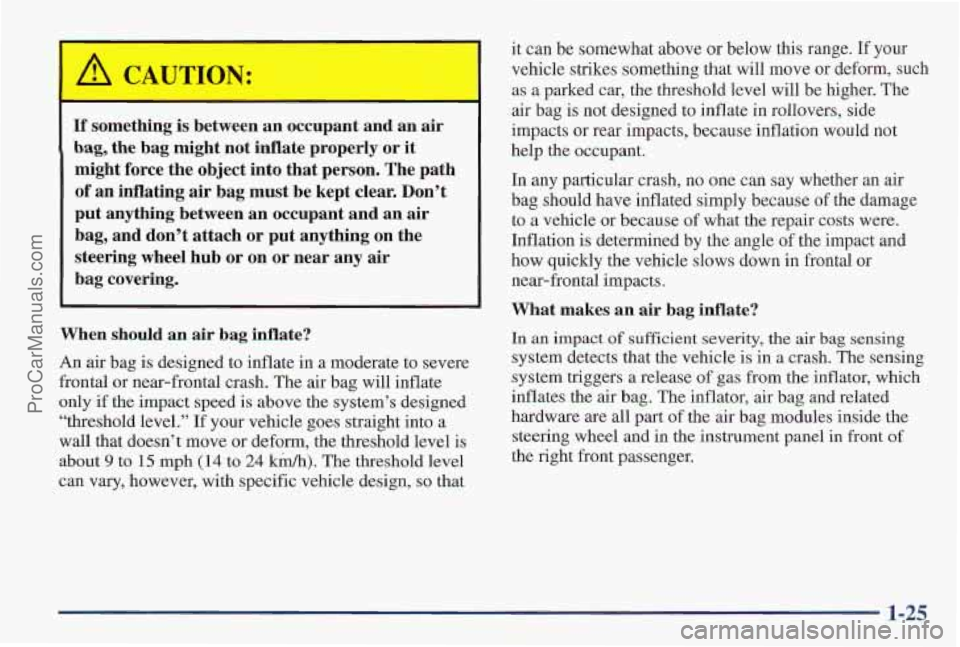
If something is between an occupant and an air
bag, the bag might not inflate properly or it
might force the object into that person. The path
of an inflating air bag must be kept clear. Don’t
put anything between an occupant and an air
bag, and don’t attach or put anything on the
steering wheel hub or on or near any air
bag covering.
When should an air bag inflate?
An air bag is designed to inflate in a moderate to severe
frontal or near-frontal crash. The air bag will inflate
only if the impact speed
is above the system’s designed
“threshold level.’’
If your vehicle goes straight into a
wall that doesn’t move or deform, the threshold level is
about
9 to 15 mph (14 to 24 km/h). The threshold level
can vary, however, with specific vehicle design, so that it can be
somewhat above or below this range.
If your
vehicle strikes something that will move or deform, such
as a parked car, the threshold level will be higher. The
air bag is not designed to inflate in rollovers, side
impacts or rear impacts, because inflation would not
help the occupant.
In any particular crash, no one can say whether an air
bag should have inflated simply because
of the damage
to a vehicle or because
of what the repair costs were.
Inflation is determined by the angle of the impact and
how quickly the vehicle slows down in frontal or
near-frontal impacts.
What makes an air bag inflate?
In an impact of sufficient severity, the air bag sensing
system detects that the vehicle
is in a crash. The sensing
system triggers a release of gas from the inflator, which
inflates the air bag. The inflator, air bag and related
hardware are all part
of the air bag modules inside the
steering wheel and in the instrument panel in front
of
the right front passenger.
1-25
ProCarManuals.com
Page 34 of 419
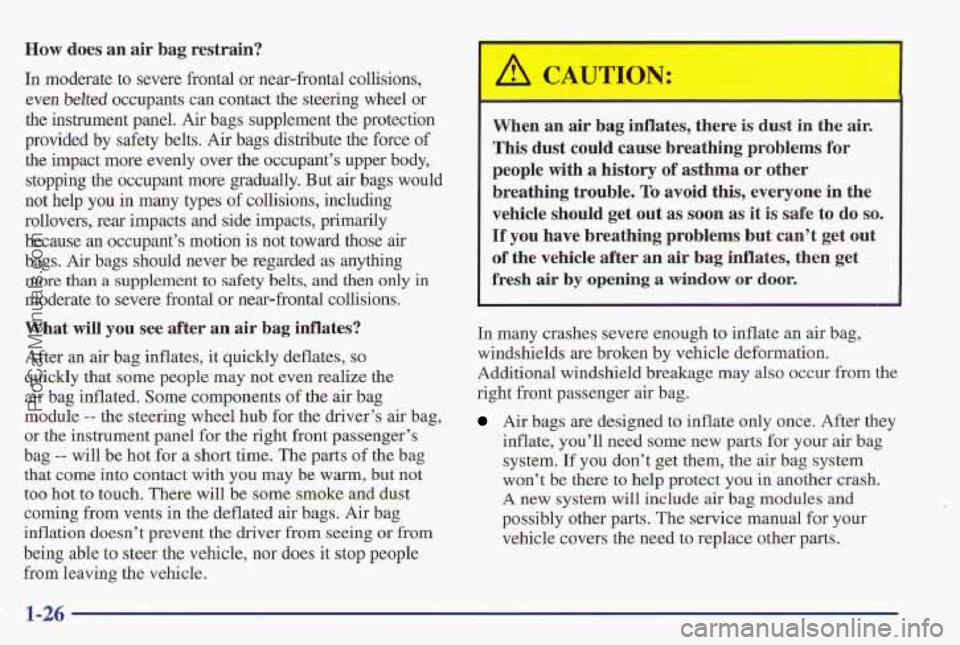
How does an air bag restrain?
In moderate to severe frontal or near-frontal collisions,
even
belted occupants can contact the steering wheel or
the instrument panel. Air bags supplement the protection
provided by safety belts.
Air bags distribute the force of
the impact more evenly over the occupant’s upper bady,
stopping
the occupant more gradually. But air bags would
not help
you in many types of collisions, including
rollovers, rear impacts and side impacts, primarily
because an occupant’s motion is not toward those air
bags.
Air bags should never be regarded as anything
more
than a supplement tn safety belts, and then only in
moderate to severe front:.- ~r newfrontal collisions.
What will you see after an air bag inflates?
After an air bag inflates, it quickly deflates, so
quickly that some people may not even realize the
air bag inflated. Some components o’f the air bag
module
-- the steering wheel hub for the driver’s air bag,
or
the instrument panel for the right front passenger’s
bag
-- will be hot for a short time. The parts of the bag
that come into contact with you
may be warm, but not
too hot
to touch. There will be some smoke and dust
coming
from vents in the deflated air bags. Air bag
inflation doesn’t prevent the driver from seeing or from
being able to steer the vehicle, nor
does it stop people
from leaving the vehkle.
When an air bag inflates, there is dust in the air.
This dust could cause breathing problems
for
people with a history of asthma or other
breathing trouble.
To avoid this, everyone in the
vehicle should get out as
soon as it is safe to do so.
If you have breathing problems but can’t get out
of the vehicle after an air bag inflates, then get
fresh air by opening a window or door.
In many crashes severe enough ta inflate an air bag,
windshields are broken
by vehicle deformation.
Additional windshield breakage may also occur from the
right front passenger air bag.
Air bags are designed to inflate only once. After they
inflate, you’ll need
some new parts for your air bag
system. If you don’t get them, the
air bag system
won’t be there to help protect you
in another crash.
A new system will include air bag modules and
possibly other parts. The service manual for your
vehicle covers the need to replace other parts.
1-26
ProCarManuals.com
Page 35 of 419
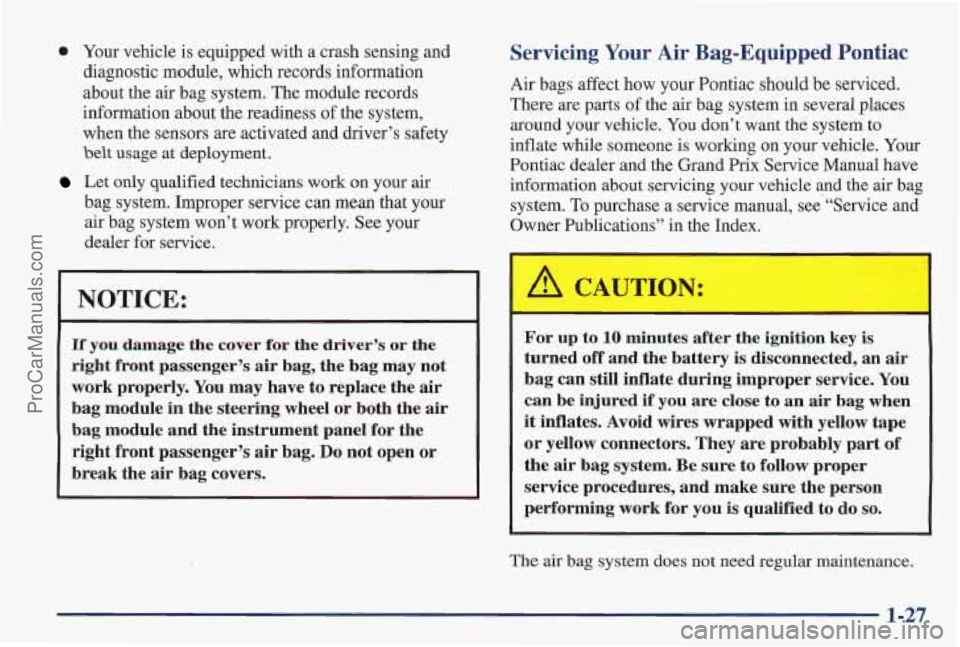
0 Your vehicle is equipped with a crash sensing and
diagnostic module, which records information
about the air bag system. The module records
information about the readiness
of the system,
when the sensors are activated and driver’s safety
belt usage at deployment.
bag system. Improper service can mean that your
air bag system won’t work properly.
See your
dealer
for service.
Let only qualified technicians work on your air
NOTICE:
Servicing Your Air Bag-Equipped Pontiac
Air bags affect how your Pontiac should be serviced.
There are parts
of the air bag system in several places
around your vehicle. You don’t want the system to
inflate while someone is working on your vehicle. Your
Pontiac dealer and the Grand Prix Service Manual have
information about servicing your vehicle and the air bag
system.
To purchase a service manual, see’ “Service and
Owner Publications” in the Index.
If you aarnage the cover for the driver’s or the
right front passenger’s air bag, the bag may not
work properly. You may have
to replace the air
bag module in the steering wheel or both the air
bag module and the instrument panel for the
right front passenger’s
air bag. Do not open or
break the air bag covers.
1 r up to 10 1 nutes af th gn. )n: y is
turned off and the battery is disconnected, an air
bag can still inflate during improper service. You
can be injured
if you are close to an air bag when
it inflates. Avoid wires wrapped with yellow tape
or yellow connectors. They are probably part of
the air bag system. Be sure to follow proper
service procedures, and make sure the person
performing work for you
is qualified to do so.
The air bag system does not need regular maintenance.
1-27
ProCarManuals.com
Page 75 of 419
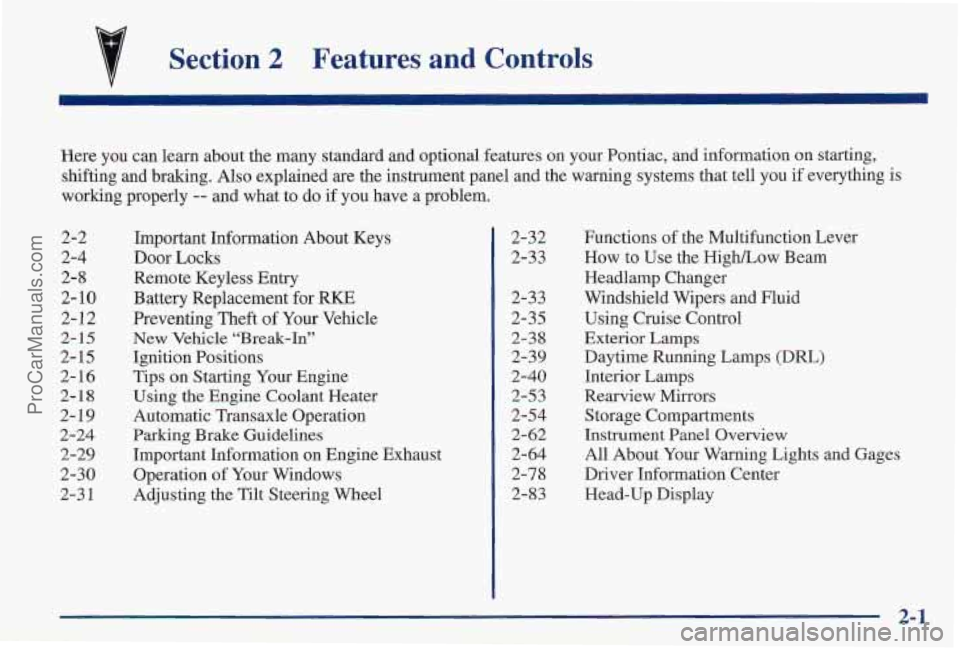
v Section 2 Features and Controls
Here you can learn about the many standard and optional features on your Pontiac, and information on starting,
shifting and braking. Also explained are the instrument panel and the warning systems that tell you if everything is
working properly
-- and what to do if you have a problem.
2-2
2-4
2-8
2- 10
2-12
2-15
2-15
2- 16
2-18
2-19
2-24
2-29
2-30
2-3 1
Important Information About Keys
Door Locks
Remote Keyless Entry Battery Replacement for RKE
Preventing Theft
of Your Vehicle
New Vehicle “Break-In”
Ignition Positions
Tips on Starting Your Engine
Using the Engine Coolant Heater
Automatic Transaxle Operation
Parking Brake Guidelines
Important Information on Engine Exhaust
Operation of Your Windows
Adjusting the Tilt Steering Wheel 2-32
2-33
2-33
2-35
2-3 8
2-39
2-40
2-5 3
2-54
2-62
2-64
2-78
2-83
Functions of the Multifunction Lever
How to Use the HighLow Beam
Headlamp Changer
Windshield Wipers and Fluid
Using Cruise Control
Exterior Lamps
Daytime Running Lamps
(DRL)
Interior Lamps
Rearview Mirrors
Storage Compartments
Instrument Panel Overview
All About Your Warning Lights and Gages
Driver Information Center
Head-Up Display
2-1
ProCarManuals.com
Page 85 of 419
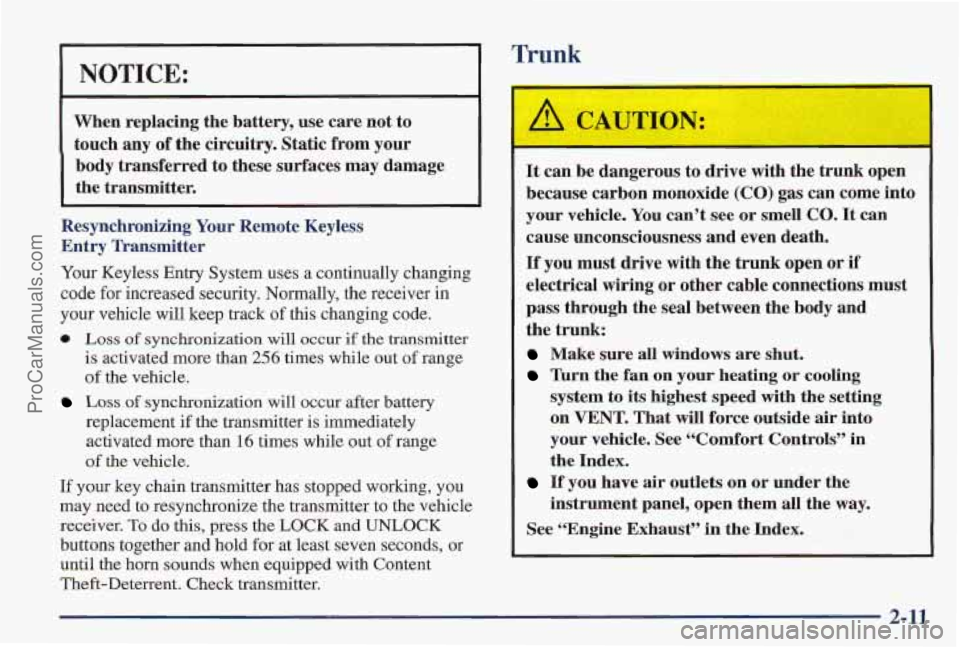
Trunk
I NOTICE:
When replacing the battery, use care not to
touch any of the circuitry. Static from your
body transferred to these surfaces may damage
the transmitter.
Resynchronizing Your Remote Keyless
Entry Transmitter
Your Keyless Entry System uses a continually changing
code for increased security. Normally, the receiver in
your vehicle will keep track
of this changing code.
0 Loss of synchronization will occur if the transmitter
is activated more than 256 times while out of range
of the vehicle.
Loss of synchronization will occur after battery
replacement
if the transmitter is immediately
activated more than
16 times while Out of range
of the vehicle.
If your key chain transmitter has stopped working, you
may need to resynchronize the transmitter to the vehicle
receiver.
To do this, press the LOCK and UNLOCK
buttons
together and hold for at least seven seconds, or
until the horn sounds when equipped with Content
Theft-Deterrent. Check transmitter.
It can be dangerous to drive with the trunk open
because carbon monoxide
(CO) gas can come into
your vehicle. You can’t see or smell CO.
It can
cause unconsciousness
and even death.
If you must drive with the trunk open or if
electrical wiring
or other cable connections must
pass through the seal between the body and
the trunk:
Make sure all windows are shut.
Turn the fan on your heating or cooling
system to its highest speed with the setting
on
VENT. That will force outside air into
your vehicle. See “Comfort Controls” in
the Index.
instrument panel, open them
all the way.
If you have air outlets on or under the
See “Engine Exhaust”
in the Index.
2-11
ProCarManuals.com
Page 87 of 419

Parking at Night
Park in a lighted spot, close all windows and lock your
vehicle. Remember to keep your valuables out of sight.
Put them in a storage area,
or take them with you.
Parking Lots
If you park in a lot where someone will be watching
your vehicle, it’s best to lock
it up and take your keys.
But what
if you have to leave your ignition key? What if
you have to leave something valuable in your vehicle?
Put your valuables in a storage area, like your trunk
or glove box.
0 Lock the glove box.
0 Lock all doors except the driver’s.
0 Give the valet key to the valet. Then take the master
key with you.
Content Theft-Deterrent (If Equipped)
If your Grand Prix has this option, it has a
theft-deterrent alarm system.
A red light located on top of your instrument panel (near
the center
of the vehicle, next to the windshield) will
flash slowly when the system is armed.
While armed, the doors will not unlock with the power
lock switch. The alarm will go
off if someone damages
the vehicle, tampers with the trunk lock, enters the
vehicle (without using the key chain transmitter or key
to unlock the doors), or turns
the ignition on. Your horn
will sound and your headlamps will flash
for up to two
minutes. The system will also cut
off the fuel supply,
preventing the vehicle
from being driven.
2-13
ProCarManuals.com
Page 106 of 419

Wm Signal/Multifunction Lever
1
I
Turn Signal and Lane Change Indicator
The turn signal has two upward (for right) and two
downward (for left) positions. These positions allow
you
to signal a turn or a lane change.
To signal a
turn, move the lever all the way up or down.
When
the turn is finished, the lever will return automatically.
The lever
on the left side of the steering column
includes your:
Turn Signal and Lane Change Indicator
0 Headlamp High/Low Beam
0 Windshield Wipers
Windshield Washer
Cruise Control (If Equipped)
c:
I
An arrow on the instrument
panel will flash in the
direction of the turn or
lane change.
To signal
a lane change, just raise or lower the lever
until the arrow starts to flash. Hold it there until
you
complete your lane change. The lever will return by
itself when you release it.
As you signal a turn or a lane change, if the arrow
flashes faster than normal,
a signal bulb may be burned
out and other drivers won’t see your turn signal.
2-32
ProCarManuals.com